Film Name: 铃芽之旅 / Suzume
Over the past week or two, I’ve been hit hard by Makoto Shinkai’s domestic promotional tour, which culminated in the new Suzume film’s mainland pre-sale box office topping 100 million yuan, and yesterday setting a new record for the first day’s box office of a Japanese animated film ($95.37 million). This result in my knowledge is really a bit outrageous, can only be attributed to the publicity is strong enough and Makoto has the audience base – however, I watched the film after some new ideas, perhaps this film will become a new sea of Makoto’s “road” the best of a film, precisely because it is “very not new”. Because it’s “not Makoto Shinkai”.

In terms of content, Suzume can be seen as the culmination of the director’s past work, but in terms of substance, the director tries for the first time to take a break from the bond between teenage girls and boys and extend the delicate sense of connection to society as a whole, so that the disaster and attitudes towards it are treated as protagonists as well. I don’t know if this is a good or bad change, but I’m sure the film will bring up a lot of discussions that go beyond the “traditional Makoto Shinkai film”, and that’s what I’m most interested in.
[Friendly reminder: there will be spoilers below].
When I talk about animated films, I can’t help but talk about the graphic performance first, but this time I can talk less about it. Suzume is a masterclass in Makoto Shinkai’s aesthetic style, and we can see shades of many of the director’s past works in it – the beauty of 5 Centimeters per Second, the generosity of Your Name, the meticulousness of Weathering With You, and the subtlety of Kotonoha no Niwa, to name a few.
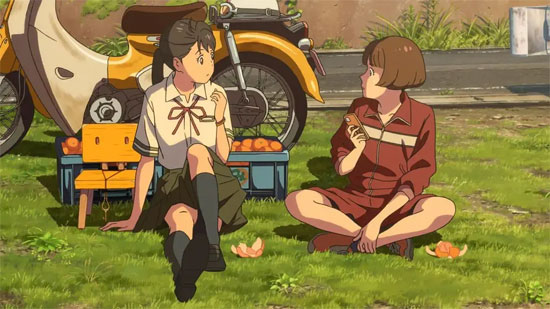
While beautiful, the film doesn’t break much ground from its predecessor, or at least nothing that caught my eye enough to make me want to give it more credit than it deserves. More often than not, Suzume doesn’t allow you to take a moment to enjoy the scenery or feel the atmosphere, but instead puts the viewer on a rushed journey through Kyushu, Shikoku, Kobe, Tokyo, Miyagi (or Fukushima), and a not-so-easy journey. Therefore, the film is “very Makoto Shinkai” on the surface, but the rest of the film is “anti-Makoto Shinkai”.
The biggest problem of the film is the deep connection between the heroine, Suzume, and the hero, Kusuta, which is too abrupt and given in vain. Just by a quick glance, they go on the road together in a haphazard manner, and it also turns out to be a “must-have”, which is obviously too casual and sloppy compared to the director’s past work.
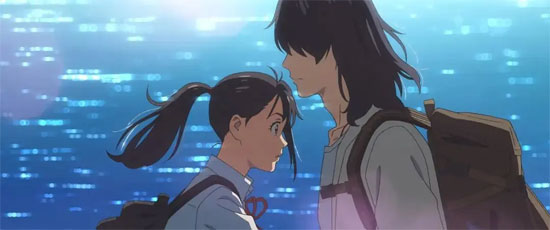
Of course, this can be explained by the fact that Suzume met Kusuta and her grown-up self in the Tokusatsu when she was a child, not for the first time, and that she would inevitably be interested in the man she “liked” as a child. But this simple structural explanation comes at the end of the film, and even if it is softened by the fact that Kusakuta appears as a three-legged chair for most of the film, it does nothing to dispel the viewer’s discomfort.
If you’re having a bad time with the film, it probably stems from the pair’s shaky character relationships.
Apart from Suzume and Kusuta’s male-female relationship, Suzume enhances the relationships between the rest of the characters, such as Suzume and her friends on the road, Minoru Okabe and Iwato Kuan, Serizawa and Kusuta, etc., and the best one is Suzume’s mother-daughter relationship with Kuan’s aunt, who says: “I feel ashamed of you, I resent you, and I hate you, but I love you even more. I love you more than anything else.
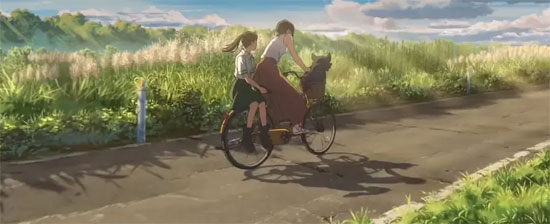
These relationships are undoubtedly richer and more varied, but to some who enjoy Makoto Shinkai’s work, they seem muddled and impure. Makoto’s past works, the fated bond between men and women is higher than everything else in the world, they only have each other in their eyes, the value of their own existence is often bound to each other, in that full and full of love and attachment, there is no room for anything else, even if you want to shoulder the responsibility of other things, but also just by the way for the …… “Suzume” the biggest “deviation”, is that it is no longer limited to the individual boy and girl, but also to the young man and the young woman. Suzume’s greatest “deviation” is that it is no longer limited to the personal world of young boys and girls, but has generated more connections with the outside world, and has shown and assumed more social attributes. Also taking natural disasters as its theme, the meteors and rainstorms in Your Name and Weathering With You are just narrative devices, but in Suzume, the earthquake becomes the story itself, and many settings such as Earthworm, Wanting Stone, Closed Door Masters, Past Doors, and Everlasting Seasons, are all designed around this catastrophe.
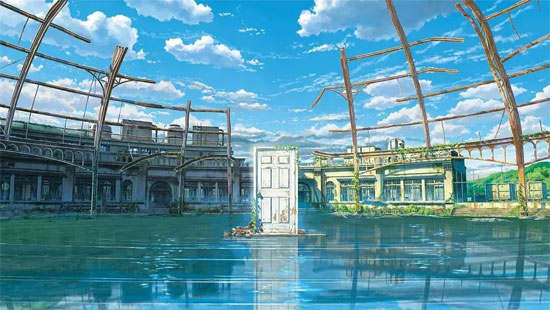
As we all know, earthquakes are as common a curse to the Japanese as anything else in the world, and Suzume was created out of the 2011 3.11 earthquake, which has a wide popular base in its home country. The film’s setting and imagery is what attracted me the most: the Tokoyami is a place where the dead reappear, and where the plagues reside, where all timelines converge, and whose existence itself has no attributes of good or bad. I was concerned about the shape of the earthworm doom because it resembles earthworms, which are responsible for making the soil fertile and protecting the ecology. I found out that the Japanese once believed that earthquakes were caused by the movement of a long, giant creature under the Japanese archipelago …… This inspired Makoto Shinkai to design Earthworm as a soil-eating creature that enriches the soil and causes earthquakes.
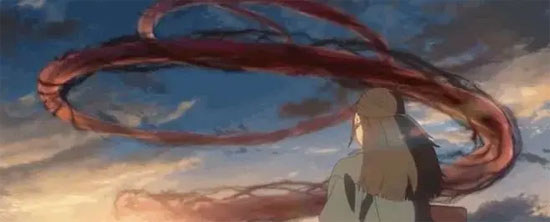
This clever idea takes care of the weight of the folklore, but also connects it to more modern meanings related to the ecology of the Earth. To get to the real world, the earthworms must pass through the “boundary” of the gate, which is usually found in ruins.
Abandoned hot spring streets, washed away schools, closed down amusement parks, destroyed homes …… once bustling with people and now in disrepair, together constitute the qualities of Kuromon: abandonment and oblivion. Only the door underneath downtown Tokyo is a bit out of place, but its essence remains the same: a place of loneliness that has disappeared from people’s hearts.
As I watched the film, it was hard not to be reminded of the reality of Japan’s severe underpopulation and ageing, with the whole country flocking to the Tokyo metropolitan area and the population of the rest of the country declining – the area in which human beings live is gradually shrinking, and nature is reclaiming its territory.
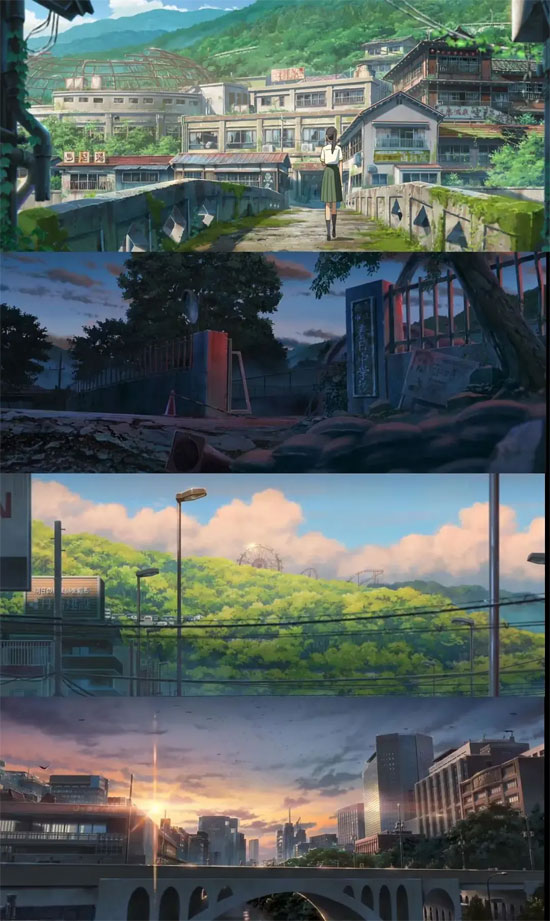
Makoto Shinkai expressed similar sentiments in an interview, and this idea is combined with Japan’s unique aesthetics of physical sorrow and post-apocalyptic sentiment to form the unique characteristics of Suzume. The film is essentially a ritual for the disappearance of land, towns, and people in ruins, a eulogy to make the parting that has already taken place more ceremonial, and to make the emotions that are already there less “dry”. For example, Suzume is particularly fond of using old things: the crippled three-legged chair that Kusuta possesses is a gift made by Iwato Tsubame for his daughter; Serizawa’s seemingly cool sports car is actually a second-hand item that is worn out; Auntie Huan chases after Suzume on an old bicycle that has been thrown away by the side of the road; and Suzume is able to retrieve the memories of her early childhood by digging up the “treasure box” that was buried in the ground! “Looking through the diary ……
All of this conveys a nostalgic yet positive sentiment: remembering is a far more powerful force than forgetting, and this is the attitude we should have in the face of disaster, and in the aftermath of it.
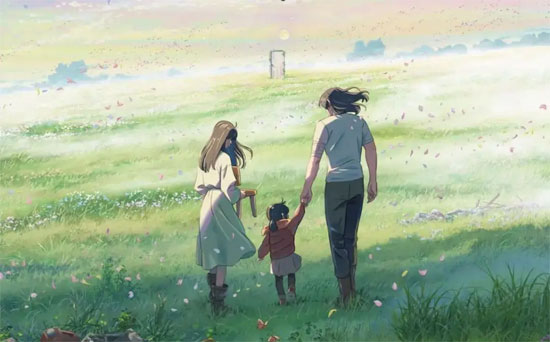
In the regular world, Suzume, a 5-year-old orphan, retrieves a chair made by her mother, and Suzume, a 17-year-old girl, retrieves Kusatsu, and gives the seeds of bonding to her former self – the path to the future, which has always been hidden in the past. It has to be said that Suzume’s character relationships and characterisation have given way to a greater extent to the interpretation of the intention, so I’m afraid that the viewing and evaluation will not be too good, but it will be a much more universal film, which as Makoto Shinkai says, “has the strength and hope to encourage viewers to reconcile with the past, and also bring with it the courage to start afresh. “
Please specify:Anime Phone Cases » Suzume 2022 Film Review: The Future from the Past